|
On
the Founding of the Knights of the Drop Leaf Table and the Finding
of the Holy Pail:
It
is perhaps fitting to start the account of our journey with some
history. Jineen, my
sister Patty, and I made a trip to
Ireland
in January of 2001. We
had lots of fun, plenty of laughs, and we experienced some Amazing
Adventures.
Exploring
castles has been our specialty.
On one particular occasion on this earlier trip, we visited
the
Cahir
Castle
, a magnificent huge fortress right in the town of
Cahir
. It was built in
the 1300s, and it has been restored, so you can go through it and
explore. We followed many narrow hallways, steep winding
staircases and secret passages. In places, the walls of this
ancient stronghold are up to 18 feet thick. The windows are
narrow vertical arrow slits, and there are special chutes for
dumping rocks and boiling oil down on the heads of attackers below.
Cahir
Castle
is truly spectacular, like your best fairytale imaginings of what a
medieval castle should look like; in fact, it was used to film the
movie ‘Excalibur.’ We
entered the Great Hall, where the feasts and meetings took place;
there was a beautiful old intricately-carved wooden table in the
center of the room. The whole setting made us feel like we
were in a King Arthur legend, complete with the Knights of the Round
Table. In fact, we were saying that the table in the Great
Hall should be round instead of rectangular, when we noticed, over
in the corner, a small oval table. It was a modern table with
ends that drop down, put there for clerical purposes. So
Jineen, Patty and I immediately dubbed ourselves 'The Knights of the
Drop-Leaf Table'!
Of
course, Knights must have a Quest.
The
day before we visited Cahir (on this earlier trip in 2001) our
friend Clare had told us a story about a friend of hers named Mick,
whose hobby was searching for old artifacts.
He and his son were exploring with a metal detector, and they
discovered an ancient and priceless chalice!
It was an incredibly beautiful piece, thought to date from
the early 9th century; it is made of silver, with gold
filigree and ornaments of amber and bronze.
It became known as the Derrynaflan Chalice.
Clare then went on to explain to us that there was great
controversy over ownership of the treasure; the Irish Government,
the landowner, and the finders of the chalice all claimed rights to
it, and they were tied up in litigation for years!
|
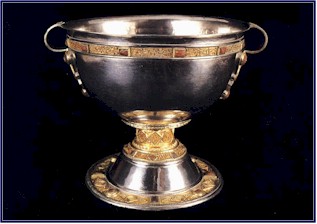
The Derrynaflan Chalice
|
On this particular evening, we three knights decided to storm
a castle. We had noticed
one in a pasture not far from where we were staying, one of those
lovely little ‘everyday castles’ that we admire so much, and we
thought it would be fun to explore it.
This venture was made more exciting by the fact that the
night was dark, we did not have permission to be there, and we had
imbibed several pints of ale at the pub before setting out.
We
snuck across the field, only to find the door of the castle barred
and locked. But
undaunted, we discovered a hole through the wall near ground level
that we could crawl through to get inside. After all, knights
must be resourceful! It
was pitch dark inside, so we made Jineen go first.
Once inside, we were groping around in the dark, wishing for
a torch (Irish for flashlight), when suddenly Jineen stumbled across
a treasure. Now some people with less of an eye for
ancient artifacts and history than us may have thought the prize was
a beat up old tin bucket or grain scoop, but the three of us
immediately recognized its true worth. Jineen held it up and
said triumphantly, 'Look, a Chalice!’ We immediately named
it 'The Holy Pail.' We
decided not to tell the Irish government.
|
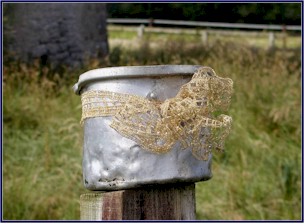
The
Holy Pail
|
As you can well imagine, with this history, we were very
excited to go back to
Ireland
for the
Reunion
of the Knights of the Drop Leaf Table!
In honor of this momentous occasion, we made the difficult
decision to take the chalice back to
Ireland
with us, despite the danger that the Irish Government might try to
claim it. We decided we
could smuggle it in to the country disguised as a cross-country
helmet, covered with a silk helmet cover.
Actually, getting it in to
Ireland
was not our main concern; bringing it home again would be the big
risk. But as Knights of
the Drop Leaf Table, we felt that we were up to the challenge!
Jineen and I flew out of
Washington
and changed planes in
Boston
. We were to meet Patty
in
Ireland
; her flight was due to arrive at
Shannon
about an hour after ours. But
as things turned out, she made it there long before us; our flight
was delayed by more than four hours in
Boston
.
Eventually
we all arrived in
Shannon
, tired and jetlagged from the overnight flight.
We collected our rental car, a nice little blue Laguna, piled
our luggage in the back, hopped in, and prepared to set forth.
I went to put the key in the ignition switch to start it up,
and discovered . . . no key! Attached
to the keychain was a card. Sort
of like those modern hotel ‘keys’ that look like a credit card.
Also, no ignition switch.
OK, this was unusual, but certainly KotDLT should be able to
cope. Sure enough, after
searching, we presently found a niche under the dashboard that the
card fit into. I shoved
it into the slot with a satisfying click, and . . . nothing
happened. Well, not
exactly nothing; this did seem to activate the power, so now the
windows and lights worked, but the car still wouldn’t start!
Eventually, after extensive trial and error, we pushed a
small button, much like a radio dial, that was hidden behind the
steering wheel. This
started our car! Now all
that was left was to figure out how to release the parking brake,
and eventually we were on our way!
They were having a heat spell when we arrived; the
temperatures went into the high seventies during the day – very
hot for
Ireland
! This proved fortunate
almost right away, as it meant that Jineen had her window open when
I hit the signpost with the car’s rearview mirror.
I have had plenty of practice at driving on the left side of
the road, but I never get used to how they park the cars in the
street in the towns, leaving only a lane and a half for traffic from
both directions to squeeze through.
I misjudged a bit, and the mirror came flying in the window
and landed on Jineen’s lap! We
were later able to snap it back into place, but dismayed to find
that the paint was badly scratched on the back of the mirror holder.
We decided we would need to disguise the damage before
returning the car at the end of the trip; maybe we could get a bird
to poop on it to camouflage it!
We met up with our friend Clare, and showed her the Chalice; she was
duly impressed that we had brought it back to
Ireland
despite the risks. We placed it proudly on the dashboard of
the car, discreetly concealed by the helmet cover; it rode there for
the duration of the trip.
|
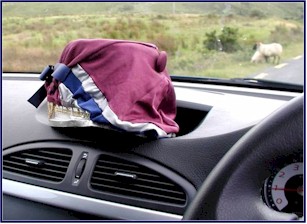
Our Chalice travels incognito
|
As is our usual custom, we spent the first three days of the
trip on business, looking at horses for possible purchase; this left
the last three days for exploring.
As we often have in the past, we stayed at Mrs.
O’Sullivan’s, a lovely Farmhouse B&B near Cashel, in
County
Tipperary
. From this central
location, we covered quite a lot of territory all over the south if
Ireland
, and saw plenty of lovely horses.
It is always great fun to visit the different stables and
yards; looking at horses is one of my favorite activities, and many
of the people we have encountered this way over the years have
become friends. It ended
up being a successful trip; I arranged to purchase two lovely young
horses that I think are really outstanding.
Not that our horse shopping was
without incident! At one
point I was trying out a horse that seemed to lack some enthusiasm
about the jumps. Deciding
to test his boldness, I pointed him at a small fence he hadn’t yet
gone over, and indeed my doubts about him proved valid:
he started to jump, then tried to stop, then at the last
moment hurled himself at the fence, crashing through it.
Unfortunately, this also sent ME crashing; I landed on the
rock-hard ground with considerable force.
I wasn’t really injured, but my backside ended up being one
huge bruise! This made
sitting very uncomfortable for the rest of the trip.
But a couple of pints of Smithwicks in the pub that night did
help!
The highlight of the first part of the trip was being asked
to dinner at the home of some of Clare’s friends, where we were
served a fabulous meal. It
was on a beautiful farm, and it was a pleasure to enjoy good food
and super company in a lovely stately old house.
But
even more importantly, it was our chance to meet Mick, the Finder of
the Derrynaflan Chalice! Yes,
the very same man who had, years before, found the priceless
artifact while out metal-detecting, and subsequently endured the
Irish courts concerning ownership.
What an honor it was to meet this man, and to hear the story
of him finding the Chalice! He
told us about what an incredible moment of awe it was when he
uncovered the treasure, and how its finding was one of the high
points of his life! Mick
is a very interesting and charismatic speaker, and we thoroughly
enjoyed his account.
We
decided to share with him and the others present that night the
story of the finding of our own Chalice.
After dinner we brought it in from the car, and when we
carefully removed the helmet cover and revealed to the group the
magnificent grandeur of The Holy Pail, everyone was predictably
awestruck. Mick, being
considered somewhat of an authority on chalices after his famous
discovery, was suitably impressed.
He pointed out what we had long observed; The Holy Pail is
very similar in looks and type to the Derrynaflan Chalice; the gold
filigree in particular enhances this impression.
Eager to avoid any legal concerns such as Mick had endured,
we asked everyone present at the dinner party to protect the secret,
and swore them to silence.
|

The
Derrynaflan Chalice and The Holy Pail – the likeness is
remarkable!
|
The next morning, the fourth day of our trip, and horse
business concluded, we set off to explore.
Our first stop was to visit the castle where we originally
found the Holy Pail. This
is a small ‘everyday castle’ in a crop field, quite near the new
Cashel Bypass road. We
felt that it was appropriate to take the Chalice back to visit its
former resting place. We
have been to this castle several times on previous trips, but this
was the first time we had ever visited it in the daylight!
|
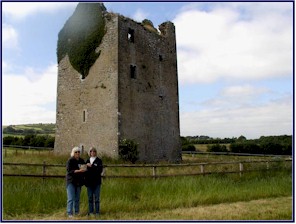
Patty and Jineen at the
Chalice
Castle
|
We were discovering that our car seemed to have a mind of its
own. For instance,
sometimes the car would lock itself when you got out of it.
It didn’t do it all the time, apparently just if it felt we
were in a bad neighborhood or something.
Also, it seemed to be in total control over whether the
interior lights were on or off; any attempt by us to influence this
was in vain.
We stopped by a roadside stand for some Wexford strawberries,
checked out a very nice antique store in Cahir, and then set out to
cover some ground. We
were heading up to
County
Mayo
; we had plans to explore the Atlantic coastline up north of
Connemara
. On the way, we went
searching for castles.
One
of my favorite things about
Ireland
is the abundance of ancient castles, abbeys, and churches dating
back, in many cases, over a thousand years.
Jineen and Patty share my interest, and we really love to
find and explore these old ruins.
Some of them are rebuilt and maintained and open to the
public, while others are crumbling to pieces in some farmer’s cow
pasture. There are so
many of them in Ireland that most of the people who live there take
them for granted, but we are fascinated by them, and consider them
an important part of the heritage of the country.
We wanted to visit as many as we could; after all, we were
the Knights of the Drop-Leaf Table!
We
stopped first by the
Burncourt
Castle
, south of Cahir. This
was a fairly large castle right by the road; but as is often the
case the doors were barred and locked.
Despite Jineen’s best efforts, we couldn’t find a way to
get in.
|
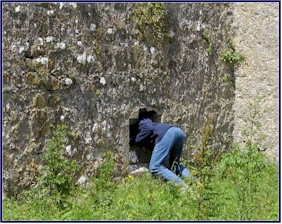
Jineen attempts to storm
Burncourt
Castle
|
We decided to name the car Christine.
It seemed appropriate; like the car in the Steven King story,
she seemed to want to be in charge.
The windshield wipers would turn themselves on and off at
will, and they would slow down and speed up according to how hard it
was raining, or according to Christine’s mood.
Next we visited the
Ballynahow
Castle
, north of the town of
Thurles
. I had been there
before, but neither Patty nor Jineen had seen it.
Ballynahow is one of the best sorts of castle to explore; it
has been partially restored, so that this lovely piece of history is
preserved, and you can go all through it.
Although it is open to the public, it is very quiet and
private; I have been there 3 times and have never seen another soul.
It sits beside a farmyard, and the guidebook says that if it
is locked you can go knock on the farmer’s door and get the key;
but we found the door open.
|

Ballynahow
Castle
|
Ballynahow
Castle
is fairly small, with a spiral stone staircase leading up six
stories to the top level, where you can come out onto the parapet
and look out over the fields below.
It is built for defense, with arrow-slit windows and murder
holes, slots where you can throw rocks down onto your enemies below.
We noticed that we had parked the Christine directly under
one of these murder holes! We
resisted the temptation to throw rocks down on her.
(KotDLT are known for their restraint!)
|

Christine
through the murder hole
|
We came presently to the River Shannon, and visited the
Clonfeit Cathedral, also known as St. Brendan’s Cathedral.
This lovely old church has an arched doorway that is over
1000 years old. The
stone walls of the interior are accented by brilliant stained-glass
windows, and carved wooden pews face the front, with its mosaic
tiled floor and a beautiful old pipe organ.
The church is still in use, it sat ready for services.
Around
back was a place called the Bishop’s House; it is owned by a
self-proclaimed healer, who runs it as a business.
We found out that he bought the healing powers along with the
house! Now it is a
proper tourist trap; we avoided it like the plague.
We
presently came upon
Clonony
Castle
, a beautiful large castle ruin beside the road.
It looked very intriguing but we couldn’t get in; the gate
was locked. We asked
about entrance at a house across the street and were told that the
castle was owned by an American lady who lived down the road, and
she would give us the key. But
when we went to her house nobody was home, and we had to leave this
castle unexplored. But
the American ownership sounded encouraging; I have often fantasized
about having my own castle in
Ireland
!
We
followed the river to a place called Clonmac Noise, a group of ruins
of 7 churches on 7 hills. We
found it disappointing because, one, they charged admission, and
two, it was closed anyway. Its
not that we mind the principle of paying a fee, but more that the
sort of places that charge one (with some notable exceptions) are
usually the crowded sort of tourist places we like to avoid.
We prefer the old ruins that few people notice!
We came to an area of peat bogs.
The turf is harvested; it is cut into bricks to be burned as
fuel. This seemed to be
the main industry of the area we were in; we saw stacks of drying
peat in the fields we passed. In
the road were many peat bricks that had dropped off of wagons
transporting them; we picked one up in case we wanted a
“candlelight dinner” later!
We
started looking for a nice spot to have Happy Hour.
This was a tradition that Jineen and I had started on
previous
Ireland
trips, and perfected when we visited
New Zealand
. You obtain a bottle of
wine and some food, and then find a beautiful spot to sit and enjoy
an impromptu picnic. We
were quite hungry and ready for Happy Hour, which was also on this
occasion to serve as dinner. Now
all that we needed was a location!
A high cliff overlooking the River Shannon would be suitable,
or perhaps a secluded castle ruin.
But at the moment we were on some little back roads with not
much view, and all we could see were the peat bogs!
Heading northward, we passed a signpost for
‘Clonfinlough Stone’, and we thought it sounded intriguing; it
promised to be just the sort of off-the-beaten-path destination that
we liked. We
figured it was probably a significant obelisk or stone circle; no
doubt an ancient Druid site of worship and sacrifice.
It had potential as a perfect spot for Happy Hour, so we
decided to check it out.
We
turned down a narrow lane and followed the signposts for several
miles, then found a small parking area beside the entrance to a
well-worn path. Obviously
the Clonfinlough Stone was a popular attraction!
We hiked a mile or so through a wooded path, trying to avoid
muddy ground underfoot and persistent flies buzzing around our
heads, and at last came into an open field at the end of the path
where we found . . . a rock! And
not some impressive or important looking standing stone or unusual
rock formation, but just a plain ordinary-looking largish stone
partially sticking up out of the grass, looking very much like about
ten thousand others we had seen.
The only feature it had that was at all unusual was an
indention in the top of it that looked very much like a footprint;
otherwise it was unremarkable. There
was a sign identifying the stone, but with no explanation of its
purpose or use. We
decided to sacrifice Patty.
|

We
offer Patty to the ancient gods
|
The maps and signposts pointing out interesting antiquities
and historical sites in
Ireland
are surprisingly inconsistent. We
always find it amazing the way something as seemingly insignificant
as the Clonfinlough Stone will be marked on maps and signposts, and
yet grand and historic castles, even those open to the public, will
often be unmarked and overlooked.
|